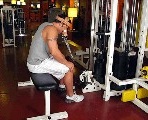The Neck
The neck supports the head and keeps it aligned with the body. It’s at the highest most part of the spine. The spinal column extends from the base of the skull to the pelvis. The neck is created from vertebrae, joints, and muscles. The neck is the start of the spinal column and neck anatomy is a well-engineered structure of bones, nerves, muscles, ligaments and tendons. The cervical spine or (neck) is delicate – One of its primary goals is housing the spinal cord which is responsible for sending messages from the brain to control all aspects of the human body.
Function of the neck:
One primary function of the next is to support the head. The neck additionally contains many blood vessels that enable blood to be transferred to and from the brain. The neck also contains the higher spinal cord, that controls body movements and is connected to the brain stem within the neck.
Benefits of Neck Exercise:
Exercising your neck can make it stronger, more flexible and reduce neck pain that is caused by stress and fatigue.
Exercising the neck muscles has three benefits:
• It strengthens the muscles of the neck, upper back, and shoulders
• It makes the neck more flexible, increasing its range of motion
• It relaxes the neck and reduces pain
Cable Neck Extension
Instructions:
• Face towards the pulley; sit on a bench.
• Put the harness cable attachment around your neck.
• Place the forearms on the lower thighs for support.
• Move your head away from the pulley, by hyper-extending your neck.
• Bend forward until your chin touches the upper chest.
• Return and repeat.
Tips for Neck Exercise:
• Before you begin a neck exercise program, consult with a healthcare professional, particularly if you have had a recent accident involving your neck or a history of neck problems.
• Stretch slowly, and avoid explosive movement.
• Breathe slowly and deeply as you exercise. Never stretch to the point where it’s no longer comfortable.
• Go to a point when you’re feeling a mild tension, and relax as you hold the stretch. The sensation of tension should go away as you hold the position.
• Do five repetitions for every exercise unless a healthcare professional has requested a distinct variety of repetitions.











